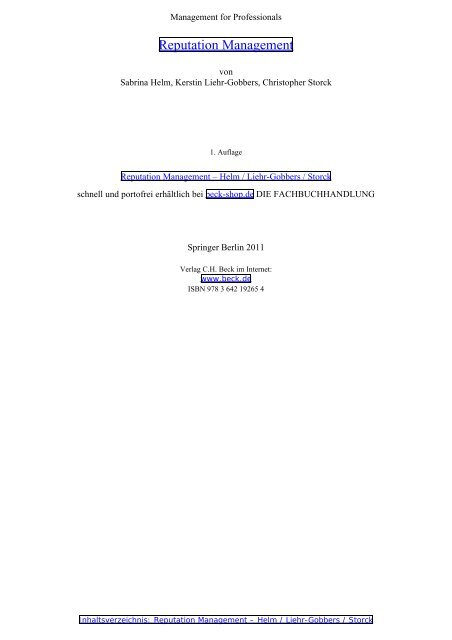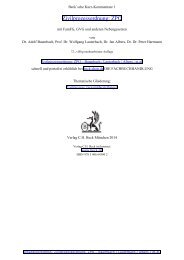Reputation Management - Helm / Liehr-Gobbers / Storck ...
Reputation Management - Helm / Liehr-Gobbers / Storck ...
Reputation Management - Helm / Liehr-Gobbers / Storck ...
You also want an ePaper? Increase the reach of your titles
YUMPU automatically turns print PDFs into web optimized ePapers that Google loves.
<strong>Management</strong> for Professionals<br />
<strong>Reputation</strong> <strong>Management</strong><br />
von<br />
Sabrina <strong>Helm</strong>, Kerstin <strong>Liehr</strong>-<strong>Gobbers</strong>, Christopher <strong>Storck</strong><br />
1. Auflage<br />
<strong>Reputation</strong> <strong>Management</strong> – <strong>Helm</strong> / <strong>Liehr</strong>-<strong>Gobbers</strong> / <strong>Storck</strong><br />
schnell und portofrei erhältlich bei beck-shop.de DIE FACHBUCHHANDLUNG<br />
Springer Berlin 2011<br />
Verlag C.H. Beck im Internet:<br />
www.beck.de<br />
ISBN 978 3 642 19265 4<br />
Inhaltsverzeichnis: <strong>Reputation</strong> <strong>Management</strong> – <strong>Helm</strong> / <strong>Liehr</strong>-<strong>Gobbers</strong> / <strong>Storck</strong>
<strong>Reputation</strong> <strong>Management</strong><br />
Kerstin <strong>Liehr</strong>-<strong>Gobbers</strong> and Christopher <strong>Storck</strong><br />
Six basic ideas about managing corporate reputation:<br />
It is reputation that drives corporate value in the first place<br />
Corporate value depends on the behavior of various stakeholder groups<br />
<strong>Reputation</strong> management aims at creating shared interests with stakeholders<br />
Stakeholder perception is generated by every member of an organization<br />
Building and protecting the right reputation is a fundamental part of leadership<br />
<strong>Reputation</strong>al goals need to be linked to corporate strategy<br />
In July 2010, the results of the European Communication Monitor illustrated that<br />
corporate communication was facing a game change. The 1,863 communication<br />
professionals from 34 European countries who took part in the survey saw a priority<br />
shift. They expected enabling managers to engage employees in corporate strategy<br />
and drive organizational change to become their key assignment. Apart from that,<br />
CSR and sustainability were seen as the most important disciplines within corporate<br />
communications by 2012.<br />
This new paradigm in professional communications could be anticipated at the<br />
turn of the century. The Internet became a mass medium. Economization was on the<br />
way to penetrate every aspect of life – even in developing countries. So did<br />
globalization: what Western elites had started was going to bounce back to their<br />
societies. NGOs and activist groups were on the move from do-gooders to powerful<br />
influencers in business and politics around the world. Foreseeing the consequences<br />
of these developments resulted in professional services firms combining management<br />
and communication consultancy. They were set up to enable corporations to<br />
meet the challenges of a dramatically changing business environment.<br />
As of 2006, these changes were fueled by another trend. A generation entered the<br />
stage whose members learned to use a computer before they could read or write.<br />
They found a new way to use the Internet: as a platform for social interaction. The<br />
result is highly volatile groups of people driven by shared interests. Groups of<br />
people that can act locally as well as globally. And what is even more disturbing:<br />
the inhabitants of the blogosphere create news as much as they consume them.<br />
S. <strong>Helm</strong> et al. (eds.), <strong>Reputation</strong> <strong>Management</strong>, <strong>Management</strong> for Professionals,<br />
DOI 10.1007/978-3-642-19266-1_2, # Springer-Verlag Berlin Heidelberg 2011<br />
17
18 K. <strong>Liehr</strong>-<strong>Gobbers</strong> and C. <strong>Storck</strong><br />
In such an environment, corporate communications need to do more than just<br />
relying on messages picked up by traditional media. The various groups that can<br />
influence the success of an organization ask for dialog and personal engagement.<br />
Stakeholders deploy the new interactive tools on the Internet to increase speed,<br />
reach and impact of their activities. Platforms such as Facebook or Twitter not only<br />
support existing social networks, but they also help to develop and grow new<br />
communities that not necessarily remain virtual. All of them communicate all the<br />
time, either with an organization they take interest in or about it. It is like joining the<br />
local pub group or staying at home.<br />
Since 2008, the economic crises brought about additional challenges corporate<br />
communicators need to deal with: the failure of unregulated capitalism prepared the<br />
way for a return of the state. The lay-off of hundred thousands of employees by top<br />
executives, whom the public regards as absurdly overpaid, transformed corporate<br />
responsibility into a prerequisite of financial success. Companies who want their<br />
stakeholders to prolong the social license to operate have to fulfill growing demands<br />
for sustainability and ethical business behavior.<br />
Accordingly, corporations are facing new challenges. They need to find ways to<br />
interact more effectively with more stakeholder groups. <strong>Reputation</strong> has become a<br />
prerequisite for an organizational success. It is reputation that makes a product or<br />
services portfolio valuable. What determines the price at which a company can sell<br />
a good? Production costs, material value or product quality in itself? Most price<br />
premiums can only be explained by how customers perceive the value the product<br />
will bring to them, and this is driven by reputational aspects. Quality may be one of<br />
them; business ethics and social responsibility are others.<br />
If reputation is the key driver of corporate value, managing it cannot be restricted<br />
to the communications department. It is a matter of leadership. Holding leaders<br />
across an organization accountable for it, however, asks for new approaches to plan,<br />
steer and evaluate communications.<br />
The process of finding such new approaches starts with a simple question: what<br />
is the purpose of corporate communications? Building “a good media image” or “a<br />
strong corporate brand” is definitively not the right answer. Nobody will deny that<br />
both are desirable. But is this what a company or institution wants to achieve<br />
through organizational communications? And even the fashionable answer “We<br />
want to build and protect a strong reputation” is not really clarifying but provokes a<br />
new question: what does reputation stand for? The following answer has the<br />
advantage of being practical:<br />
<strong>Reputation</strong> is the collective perception of a company or institution through its<br />
stakeholders. It is the result of an exchange of personal and conveyed experiences<br />
between the organization, its stakeholders and third parties over time. In this,<br />
stakeholders are all groups that can influence the success of an organization through<br />
their behavior – immediately or on the long run, directly or indirectly.<br />
On the basis of this, defining the purpose of organizational communications is<br />
easy. It aims at influencing stakeholder perceptions and expectations in such a way<br />
that these groups recognize shared interests with the organization and act accordingly.<br />
It is about making sure that stakeholder behavior is as much as possible in
<strong>Reputation</strong> <strong>Management</strong> 19<br />
tune with the goals of the organization. In other words: developing and protecting<br />
reputation aims at securing the willingness of internal and external stakeholder<br />
groups to cooperate. This is how communication creates value for a company or<br />
institution: through impacts on stakeholders’ minds leading to maximum cooperation<br />
leading to the achievement of strategic goals.<br />
But who are these stakeholders? Which groups need to be taken into account?<br />
What does the organization want them to do? Or not to do? And what will be the<br />
benefit of this behavior? Some obvious examples:<br />
Consumers shall buy more of our products, make increased use of our services,<br />
pay a higher price.<br />
Retail partners shall list more of our products, give us more shelf space, sell<br />
more of our goods by preferably recommending them to customers.<br />
Suppliers shall provide better services at lower costs.<br />
Capital market players shall invest more in our organization, pay a higher price<br />
for our shares and bonds, provide credits at lower costs.<br />
Employees shall be more productive, show more initiative, take more responsibility<br />
and stay longer in our organization.<br />
Future talents shall apply for jobs on their own initiative and are motivated by<br />
reasons other than payment and social benefits.<br />
Local communities and NGOs (including labor, social, environmental or animal<br />
rights activists) shall be willing to enter and maintain dialog with us – in order to<br />
increase cooperation and at least listen to us in situations prone to conflict.<br />
Policy makers and regulators shall consider the needs of our organization to a<br />
higher degree in legislative or regulatory processes.<br />
Professional mediators such as journalists and financial analysts shall increase<br />
the picking up of our key messages while limiting criticism to fact-based<br />
coverage.<br />
Who can make all of these happen? On its own, the corporate communications<br />
department can deal with the media – online and offline. But in how far does this<br />
help us to manage stakeholder expectations and strengthen the reputation of our<br />
organization?<br />
A master thesis at the University of D€usseldorf in 2008 has examined which<br />
correlation between the development of a reputation and media coverage can be<br />
proven statistically in the case of a pharmaceutical company in the US and four<br />
European countries. The development of the reputation was measured through a<br />
survey among 2,000 stakeholders of nine different groups that was repeated 1 year<br />
later. The media analysis was based on more than 4,500 articles on the industry that<br />
appeared in the 12 months between both survey waves.<br />
The study revealed that an influence between media coverage and corporate<br />
reputation was only clearly detectable with three stakeholder groups: with nongovernmental<br />
organizations, university graduates and pharmacists. The perception and<br />
behavioral intentions of six other groups were seemingly not affected by what was<br />
written in top-tier and business media.
20 K. <strong>Liehr</strong>-<strong>Gobbers</strong> and C. <strong>Storck</strong><br />
The interesting thing is that these groups – business partners, competitors,<br />
healthcare policy makers, investors and financial advisors, medical doctors and<br />
patient associations – have one thing in common: they have a privileged, direct<br />
access to pharmaceutical companies. In contrast to those NGOs, graduates and<br />
retail pharmacists are very similar to the general public in the way how they inform<br />
themselves about the industry. The study arrived at the conclusion that the more<br />
other touch points with a company a stakeholder group has, the less influence does<br />
media coverage exert on the development of corporate reputation.<br />
In other words: Experience and dialog have a higher influence on stakeholders’<br />
perceptions of a company than communication via media channels. It is therefore<br />
essential to complement media relations through platforms for direct contact with<br />
stakeholder groups.<br />
This does not mean that corporate communications cannot create value for<br />
businesses and institutions. But it clarifies that the reputation of an organization<br />
cannot be managed by the communication department alone. It is a task every<br />
member of the organization is responsible for. So who is ultimately accountable for<br />
it? The leadership.<br />
This is why accepting the challenges of the age of the stakeholder brings with it a<br />
great opportunity for corporate communications to expand its range of activities<br />
through higher business integration. The key to this is cooperation with other<br />
communication disciplines and corporate functions. Some of them have already<br />
been initiated. For example:<br />
With the HR department for employer branding<br />
With the legal- and M&A office for mergers and acquisitions<br />
With investor relations for IPOs, bond issues and other ECM activities<br />
With the CSR department for sustainable communications<br />
With public affairs for agenda setting regarding politics and regulatory bodies<br />
With the top management for internal communications<br />
Corporate communications can effectively support initiatives of this kind, as<br />
long as it is integrated in the strategic process of an organization. This is the key to<br />
determining the value creation of reputation management.<br />
Everything starts with translating corporate strategy into projects the corporate<br />
communications department can drive or support (see “How to manage reputation”,<br />
Part IV). Tracking the progress of such projects and evaluating their impact asks for<br />
more and better measurement (see “How to measure reputation”, Part III).
http://www.springer.com/978-3-642-19265-4

















